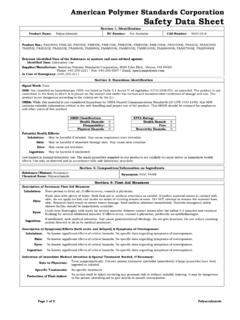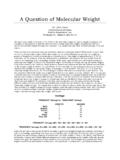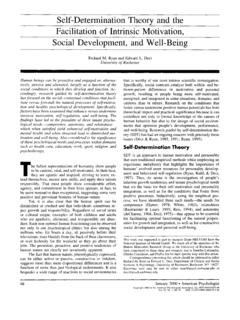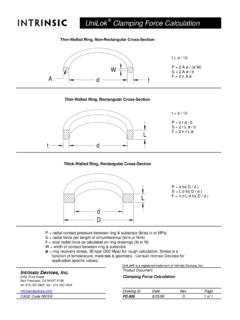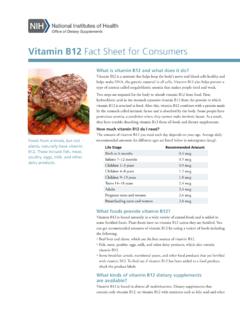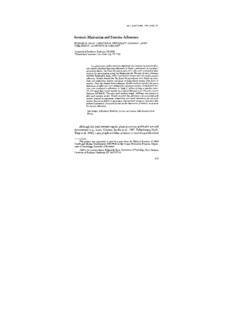Transcription of Validation of Gel Permeation Chromatographic …
1 Page 1 of 4 October 29, 1993 Validation of Gel Permeation Chromatographic Method for determination of Mn, Mw, Mv, Mp, Mz, MWD and intrinsic Viscosity of Polystyrene and other THF soluble Polymers. Objective: To validate a method to characterize the molecular weight distribution of THF soluble polymers. References: "A differential Visometer", Part II, American Laboratory April 1985. By Dr. Max Haney, president of Viscotek Corporation. "Absolute Molecular Weight Distribution of Polymer by SEC-Viscometry" By Dr. Dennis J. Nagy, Air Products and Chemicals, Inc. First International GPC/Viscometry Symposium April 1991, Houston, TX. "Principles of Polymer Chemistry", Cornell University Press, Ithaca, NY., 1953, Flory. Analytical Methodology: Operating Parameter: Equipment: Waters M-150-C ALC/GPC chromatograph equipped with the Viscotek Differential Viscometer, Model 100 Columns: Styrene-DVB GPC columns: 2 X Linear + 500 Mobil Phase: THF ( BHT) Flow Rate: Injection Volume: 150ul Reagents and Standards: THF ( BHT) Chempure, CMS Corporation Polystryene standards, narrow molecular weight distribution with known Mp and intrinsic Viscosity values (minimum number 6 standards; average number 12 standards).
2 Complete list of available standards ID enclosed. On broad MWD standard for checking out the validity of the calibration curve and the value of the intrinsic Viscosity. Preparation of Standards: 10 to 25 mgs of each standard is dissolved at room temperature in the mobile phase in cleat borosilicate scintillation vials. For example, mgs of raw material are dissolved in ml of mobile phase to obtain solution. Once the sample is in solution it is filtered using micron disk filter. AM E R I C A N PO LY M E R STA N DA R DS CO R P O R AT I O N 8680 TY L E R BL V D. , ME N T O R, OH 4 4 0 6 0 P . O . BO X 9 0 1 , ME N T O R, OH 4 4 0 6 1-0 9 0 1 PH O N E: 440-255-2 2 1 1 FAX: 440-2 5 5-8397 IN T E R N E T: M P O L Y M E O M E-M A I L: A P S C@A M P O L Y M E O M Page 2 of 4 Analysis: Each standard and each sample is chromatographed three times in order to assure reproducibility of results and to guard against unexpected instrumental upsets.
3 Systems Suitability Requirements: To insure that the instrument is operating correctly a number of check are performed. The differential refractometer should have a reading of millivolts on the detector output readout, differential transducer readout on the viscometer should be set close to zero, systems backpressure should be below 1,000psi and monodisperse low molecular weight standard peak should be symmetrical ( to skew), total number of columns plates above 20,000 plts/bank. Calculations: Unical GPC software, version (7-6-92) form Viscotek Corporation, Houston,TX is used to do all the calculations. The software manual describes in minute detail all the formulas, algorithms and convolute intergrals use for the calculations. First, peak parameters are calculated in order to determine the viscometer offset from the refractometer, peak broadening and skewing corrections.
4 Second, the Universal Calibration table and plot are calculated. Log (mp X IV*) is plotted versus Elution Volume. IV* is the intrinsic viscosity of each standard under the operating conditions of the system. Third, the unknown samples are calculated using the Universal Calibration method. For each sample the following values are determined. Mn Number average molecular weight Mp Peak average molecular weight Mv Viscosity average molecular weight Mw Weight average molecular weight Mz Z-average molecular weight IV* intrinsic Viscosity (dl/gm) Validation of the Method: Molecular weight is a weight in grams of Avogadro's number (6 X 10^23) of molecules of a substance.
5 A polymer sample does not have a single molecular weight. Since polymers are mixtures of molecules having different molecular sizes and molecular weights they cannot be characterized by a single molecular weight. All of the different molecules within the polymer sample are measured and averaged, the results is a molecular weight average. The kind of molecular weight average is obtained depends upon type of measurement used; Number Average Molecular Weight (Mn) is obtained by counting number of molecules per unit weight of sample. In this type of measurement all molecules are treated equally regardless of their weight or size. Osmotic pressure, vapor pressure, freezing point depression, boiling point elevation, hydroxyl number, carboxyl equivalent Page 3 of 4 --- all of these measurements result in the average called the number-average molecular weight.
6 Number average molecular weight is very sensitive to changes in the weight fractions of low molecular weight species, because for small molecules a small weight of material represents a large number of molecules. Another technique that is used to measure molecular weights of polymer is light scattering. A light shining through a very dilute solution of a polymer will be scattered by the polymer molecules. The scattering intensity at any gives angle is a function of the second power of themolecular weight. Because of this square function, large molecules contribute much more to the molecular weight than small molecules. This "weighted" average is called weight average molecular weight and is very sensitive to changes in the number of large molecules in a given sample of a polymer. Viscosity of average molecular weight is obtained from measurements of dilute solutions of a polymer and gives us information about the molecular sizes or volume of the polymer molecules in the solution.
7 intrinsic Viscosity is related to the viscosity average molecular weight. Large molecules contribute more to the viscosity of the polymer sample. If a dilute solution of a polymer is subjected to a centrifugal field at a fairly low speed, a thermodynamic equilibrium is established where the molecules become distributed according to their sizes. The molecular weight is obtained from this experiment is called Z-average molecular weight. Vary large molecules settle most in the gravitational field in the centrifuge and are even more important in the case of the Z-average that the weight-average or the viscosity-average molecular weight. Different molecular weight averages are significant in terms of processing a polymer and in terms of the properties of a polymer end-product. All of the above described molecular weight averages can e obtained by Gel Permeation Chromatography (GPC) in a single run in about 30 to 45minutes.
8 Flory showed theoretically that hydrodynamic volume of a polymer molecule in solution is proportional to the molecular weight time s intrinsic viscosity. Benoit demonstrated Flory's theories by showing that polymers of different chemical structures will fall on the same calibration plot if the parameter of intrinsic viscosity is available. Since GPC separates polymers by hydrodynamic volume and on-line differential viscometer provides the value of intrinsic viscosity over entire molecular weight distribution, it became possible and practical to calibrate GPC systems with known standards and get absolute molecular weights of unknown polymers. Reproducibility of Results: The chromatography system is calibrated each time samples are run to insure good reproducibility on results. In general the reproducibility of results under ideal conditions is +/- ; reproducibility month to month can realistically be +/- Page 4 of 4 Conclusion: The assay system described above is accurate and reproducible for the characterization of the molecular weight distribution of THF soluble polymers.
9 It directly measures all of the polymer and does not rely on published Mark-Houwink constants of make theoretical assumptions to derive their values. Written By: John E. Armonas/President & Polymer Chemist (10-29-1993) Reviewed: May 2002 Last Reviewed: April 13, 2015
